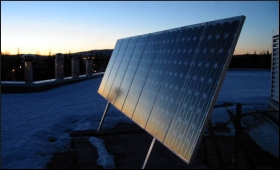|
|
|

|
As solar industry booms, time to start thinking about recycling
|
|

|
|
| Top Stories |
 |
|
|
|
Vishu Mishra | 06 Dec, 2018
One of the few encouraging trends in the global efforts on mitigating
climate change is the rapid adoption of solar energy across the world.
This change is driven by a combination of government policies and
declining costs.
The International Energy Agency (IEA)
reported that the global solar photovoltaic (PV) installed capacity is
expected to increase beyond 1,600 Gigawatts (GW) by 2030. India has set
an ambitious target of 100 GW of solar capacity by 2022, with one-fifth
of that already installed.
However, it is important to be
foresighted about potential future problems. PV panels, the most
commonly deployed solar application, will inevitably pile up as waste at
the end of their useful lives and create challenges in the absence of
an effective plan to deal with them.
Why should we worry now when
the potential problems are decades away? Consider the case of
electronic waste (e-waste). With the explosive growth in the adoption of
computers and consumer electronics over the last two decades, India is
one of the worst affected countries by e-waste, according to the United
Nations Environment (UNEP). Only recently has the Indian government
started to address the crisis. Since waste management and recycling
systems take a long time to evolve, India must start planning now to
avoid a similar situation with solar PV.
Although the theoretical
lifespan of PV panels is 25-30 years, the International Renewable
Energy Agency (IRENA) points out that multiple factors frequently
contribute to the early retirement of panels. These include improper
installation, minor manufacturing defects, poor maintenance and soiling,
and unfavourable climatic conditions. Many of us have come across
defunct solar street lights which demonstrate this unfortunate reality.
Generation of waste panels under regular and early loss scenarios in both India and the world, as calculated by IRENA are:
*
For India: Under regular loss scenario, 0.05 and 0.325 million tonnes
by 2030 and 2050. Under the early loss scenario, the figures climb to
4.4 and 7.5 million tonnes by 2030 and 2050.
* For the World, the figures are 1.7-60 million tonnes and 8 and 78 million tonnes under the two scenarious.
State-of-the-art
recycling processes can recover up to 90 per cent of the clean glass
and 95 per cent of the semiconductor materials from a retired module.
The
major components recoverable from PV waste include glass, aluminium,
silicon, copper, polymers and other minor metals. Recycling not only
prevents wastage of resources and leaching of pollutants from waste, but
is also a significant economic opportunity.
IRENA estimates
that PV recycling will become a $15 billion industry globally by 2050;
the potential for secondary raw material recovery equates to about 60
million new panels (18 GW of equivalent installed capacity) by 2030 and 2
billion new panels (630 GW of equivalent installed capacity) by 2050.
India
can learn from global best practices in solar PV recycling. For
example, the European Union's Waste Electrical and Electronic Equipment
(WEEE) directives impose recycling requirements on solar panel
manufacturers and mandate the fabrication of new panels using recycled
components.
However, the Indian E-Waste Rules of 2016 do not
include solar PV panels, which means that retired panels are dealt with
by the unorganised sector with poor recovery rates and associated
pollution.
To establish a formal recycling ecosystem, a
producer-financed compliance fee or consumer-financed end-of-life fee
can be used to create a viable financial model. This model will impose
Extended Producer Responsibility (EPR) on manufacturers, similar to the
approach being followed for e-waste.
In addition to creating
employment, the silicon extracted from retired panels could provide
high-quality raw material to strengthen the domestic solar PV
manufacturing chain, which is currently weak. Engagement of all
stakeholders is essential to develop the appropriate policy and business
framework for a circular economy approach to solar PV.
|
|
|
| |
|
|
|
|
|
|
|
|
|
|
|
|
|
|
| |
| Customs Exchange Rates |
| Currency |
Import |
Export |
US Dollar
|
84.35
|
82.60 |
UK Pound
|
106.35
|
102.90 |
Euro
|
92.50
|
89.35 |
| Japanese
Yen |
55.05 |
53.40 |
| As on 12 Oct, 2024 |
|
|
| Daily Poll |
 |
 |
| Do you think Indian businesses will be negatively affected by Trump's America First Policy? |
|
|
|
|
|
| Commented Stories |
 |
|
|
|
|
|
| |
|